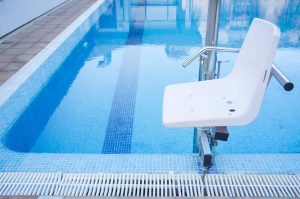If you are considering installing pool lifts for your home, there are some things to consider. First of all, there are a number of common disabilities that a pool lift can accommodate. Second, there are different types of lifts to choose from, including Hydraulic, Electric, and Manual.
A hydraulic pool lift can provide mobility assistance to disabled individuals. It is a simple device that rotates to lift a wheelchair user. This device is also designed to be portable. Visit a reliable St. Petersburg pool lift provider to see a great selection of pool lifts that suit your needs.

There are many options when choosing a lift for your pool. You can choose from a manual, powered, or electric model. Each type has different features. Your choice will depend on your pool and your disability.
For a permanent installation, you should invest in a heavy-duty lift. Ideally, you’ll want to consider an above-ground pool. These types of lifts are more dependable and easier to maintain.
Some models are also available with hydraulic ram operation. Hydraulic rams allow for a greater range of motion and safety.
There are other pool accessibility options such as pool ramps, ceiling lifts, and walk-in pool stairs. These are approved by the Americans with Disabilities Act.
When installing a pool lift for mobility assistance, there are a few important things to keep in mind. For example, the size and weight of the user can impact the type of lift required. There are three main types of pool lifts: manual, electric, and water powered. Choosing the right type of lift can be a difficult task.
A manual pool lift is typically the most cost-effective option. It requires trained staff to assist the person in and out of the pool. Some manual lifts include a mesh patient sling to help the user get in and out of the pool.
An electric disabled pool hoist is a more expensive purchase. However, it offers more flexibility for the mobility patient. In addition, most hoists offer remote controls.
When it comes to pool lifts, you can choose between electric and manual options. Among the most common are battery-powered and water-powered lifts.
These types of lifts are the cheapest. They are also the most reliable. In addition, they are easier to operate than other types of pool lifts. Nevertheless, they are not as secure as a transfer sling.
Electric pool lifts are often portable. This makes them convenient to use in public pools. On the other hand, battery power can be expensive.
Manual lifts, on the other hand, are permanently installed. They require the help of a caregiver. The least expensive option is the manual pool lift.
A powered lift will rotate 360 degrees, allowing the user to move through the water. Battery-powered lifts are popular in commercial applications. If you are considering purchasing one, make sure the battery is replaced periodically.
Adding pool lifts to a community can make it easier for people with disabilities to swim. It can also prevent discriminatory practices by enabling people with disabilities to safely access aquatic activities.
Pool lifts come in a variety of styles, and it is important to choose one that best meets your needs. You can use a manual, electrical or mechanical lift. Each type is a little different, and requires different installation techniques.
When choosing a pool lift, you should first consider your own health needs. For instance, if you have arthritis or joint pain, swimming may be a useful therapy. Similarly, people with disabilities who are experiencing fibromyalgia or rheumatoid arthritis can benefit from water therapy.
Buying a pool lift is an expensive investment, and you should consider all your options. Some lifts can be stored and brought out only when necessary, while others are permanent installations that are locked into the pool deck.
A pool lift is a device that can help you or a loved one get in or out of the water safely. These lifts are used by people who have disabilities or mobility issues. There are several types of pool lifts, including mechanical, electric and battery-powered. Each type has its own set of requirements.
The Americans with Disabilities Act (ADA) is a law that requires all public pools to be accessible to everyone. It also mandates that all commercial pools be in compliance with these rules. Pools should be equipped with ADA-compliant lifts.
Most ADA guidelines state that pool lifts must have at least two exits. One of these exits can be a ramp, a transfer wall or accessible pool stairs.
ADA requirements also require that the lift has a minimum load capacity of 300 pounds. The lift must be able to be used by a person in a chair and must be positioned at a specified water depth.